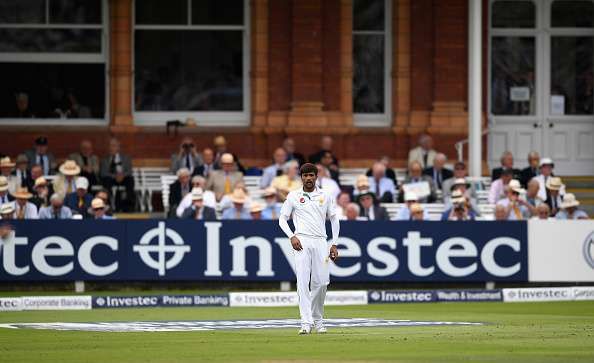
Analysing Mohammad Amir's return to Test cricket

Life is, most of the time, lived in nostalgia. The anticipation of the recurrence of an event, that has a significant part of a country’s history etched on it, creates more qualms than the event itself. Hence, quite predictably in the recent past, the questions of cricket’s sanctity being maintained were raised, and so were those related to the game’s acceptability and all-encompassing nature.
“There is one thing that is not in doubt when you discuss Amir – he can bowl,” the English Test captain, Alastair Cook, had said prior to the 1st England-Pakistan Test, about the Pakistani prodigy who was set to make his return to Test cricket at Lord’s – the same place that took the soul out of the home of cricket six years back. “Take away all the off-field stuff he will be a real challenge. The fact is you don’t see many 18-year-olds bowl like he did. He’s an exceptional talent.”
The talk before the walk
This was after Cook had explicitly expressed his opinion about the acceptance of match-fixers – which Amir certainly was – back into the cricketing galleries when he had said that ‘fixers should be banned for life.’ His fellow Englishmen, both friends, and foes had also pitched in with their own quotes on how cricket should deal with such offsprings.
While Graeme Swann, Cook's long-time teammate, had said that Amir's presence at Lord’s would make him feel ‘sick,’ another one of Cook’s teammates, although not on the same page as the aforementioned gentlemen on a whole range of issues, Kevin Pietersen, agreed with them here and said that fixers should ‘not be given a second chance.’
As I said, the anticipation of the event had created more ripples than the event itself. The decision had been made, the punishment had been served, but the customary comments and jibes filled the media in the days leading up to the series.
The players took the field on Day 1, Pakistan batted, Misbah-ul-Haq became the oldest captain in the history of the game to score a Test century – at 42 years of age – and Pakistan went to Stumps at 282/6 in their first innings. The ground was still pure, Swann’s health was intact, and so was cricket’s sanctity. The problems – whether real or farcical, is left to the reader’s judgement – began at the fall of the 8th Pakistani wicket on Day 2, when Wahab Riaz, walking back to the dressing room, crossed ways with Mohammad Amir who strode out to bat in the whites for the first time in six years.
Swann immediately called for an ambulance, Pietersen gave second thoughts about the term ‘second chance,’ and the leader of the pack, Cook, stood in observance, looking at the man who had pulled one of the most remarkable, if not the most remarkable, comebacks that the game had ever seen, all of it at the tender age of 24. Amir scored 12 off 10, with all of those runs coming in boundaries, two off Chris Woakes, and one off Stuart Broad.
His captain, Misbah, who had defied odds at his age, was arrested, finally, by Broad, who four overs later, in the fond remembrance of his career-best 169 that had come on this very ground on that fateful day, got the ‘boy’ caught by Root in the slips. That marked the end of short but eventful first burst that the most talked about cricketer of the series had upon his return from exile.

Amir at Lord’s – a moment to behold
What followed thereafter was a subdued yet promising return by the man (and he can be called a man now) to the whites. Although the better half of Pakistan’s bowling on the Lord’s surface belonged to Yasir Shah, a rather innocuous widish ball meandering outside off took Cook’s extended bat and crashed into the middle stump to give Amir’s his first Test wicket in six years. Cook’s disgust at the shot, which forced him to swipe his bat against the shattered stumps, albeit not damaging them any further, could only be matched by Amir’s trademark celebration of extended arms – Shoaib Akhtar style – with the eyes spitting fire which only he could store underneath.
England’s second innings followed a similar story. The Pakistani leg-spinner, playing only his first Test outside the UAE, bagged a ten-wicket-haul, but the cherry on the cake was to be laid by the poster boy, and deservingly so. Having bowled for 15 overs conceding runs at just over two per over, a full and straight ball angled on middle and leg was what it took for Amir to get his first recognisable impact on the series. As Broad missed, his stumps were rattled, and a few overs later, when a good length ball on leg stump beat Jake Ball’s bat – that was dangling towards oblivion – it was all over. Pakistan had won the Test and it was Amir who won it for them, at least technically.
“It's been a remarkable turnaround after the 2010 incident,” said Misbah after the game. “He's part of the team that has won the Test match, it will be one of the memorable days of his life and from here he can start his career again. He's a good kid now, he's a mature cricketer and he can prove to everyone that he's a good bowler.”
However, a return of 3 wickets for 104 runs from 36 overs didn’t exactly account for a promising comeback. In fact, had he been a debutant, it would have easily been his last Test of the season. But call it the reputation of the man, or the sheer nostalgia associated with him, everyone around the cricketing galleries knew that Amir would take the new ball for the next three Tests.